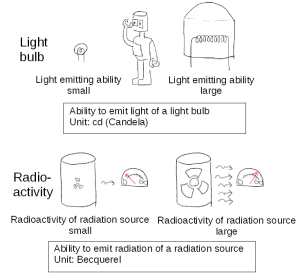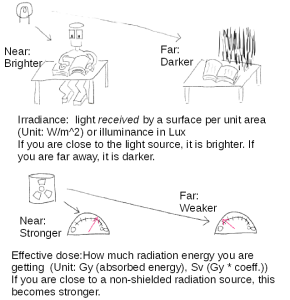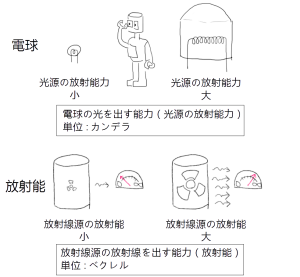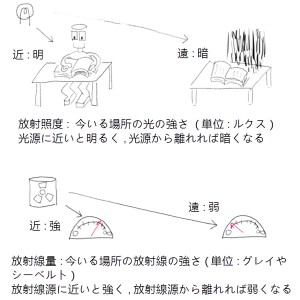[:ja]前回は,可能な限り安全性を自分で判断するためにいくつかの資料の参照先を書きました.もちろん,もっと他にも資料があると思いますので,御自分でお探しになって欲しいと思います.ここではそれらの資料を読む際に使える基本的用語などについて,補足していきたいと思います.
放射能・放射線について
前回紹介した Wikpedia や化学入門などの解説をご覧になられた方は原子というものが何かとか,放射線とは原子核の一部の陽子や中性子であったり,高エネルギーの電子であったり,あるいは高エネルギーの電磁波であったりということをご理解されたかと思います.これらが危険なのは,私達生命が生きていくために重要な私達の体の中の DNA 等を破壊することができるからです.どれだけ破壊するかというのは,放射線を放射する側のエネルギー,そして生体側がどれだけ吸収するか,などにかかわってきます.それは,どれだけ攻撃が強いのか,どれだけ守備が強いか,に似た感じです.これについて知るために,まずは,放射能と放射線と,その強さについての言葉について考えましょう.それを示す言葉がないと,なんだかわからない怖いもののままであったり,なんだかわからないから,権威の言うことを信じるしかないということになりかねません.そこで,ちょっと退屈かもしれませんが,放射能,放射線,ベクレル,シーベルトなどの言葉の意味をまとめてみます.
私がこれについて調べているうちに,放射能と放射線の関係は,光のアナロジーが使えそうだとわかりましたので,それを使って説明したいと思います.
放射能というのは放射線を出す能力のことです.つまり能力のことです.先の攻撃,守備の話では攻撃側の武器の強さの話とも言えるでしょう.光で言えば電球は光を放射する能力がありますので,電球には光放射能があると言えるでしょう.そして光そのものが放射線に対応します.図 1 に電球と放射能の対応を示します.つまり放射能は物の性質,たとえば,電球の能力に対応します.注意して欲しいのは放射能は光には対応せずに,電球に対応するということです.電球は光を出す能力がありますが,光そのものではありません.私達は電球をつかんで移動して,箱に入れ,後で取り出すことができますが,光そのものをつかんで移動させて箱に入れて後で取り出すことはできません.音でもこれをたとえることができます.スピーカーは音を出す能力がありますので音放射能があると言えますが,スピーカーは音そのものではありません.放射能と放射線の違いはこれでおわかりでしょうか?
放射線は通常原子核が崩壊すると発生します.1回の崩壊でどのような放射線が出るかは原子核の種類によって違います.そして,ある単位質量の物質が1秒間にどれだけの崩壊を起こすかの数をベクレル(Bq)という単位で示します.これが攻撃武器側の強度です.単位質量というのは 1kg や 1t など,ある決まった量のことをちょっと難しく(しかし正確に)言っているだけで,何か決まった重さのことです.(正確には重さは場所,たとえば地球上と月の上では変化するものであり,質量は場所で変化しないものなので違うものです.しかし,とりあえずは重さと考えても通常はさしつかえないでしょう.)
どうして単位質量というものを考えるかというと,電球が沢山ついていれば明るくなるように,同じ放射能(Bq)の物質が多量にあればその分だけ多く放射線が出るからです.ですから,通常は 1kg の何かの中にこれだけの Bq という意味で,Bq/kg というような単位になっています.たとえば,ある放射性廃棄物 1kg あたり 8000 Bq とあれば,この 1kg の廃棄物は1 秒間に 8000 回の崩壊を起こします.そして,通常,それに対応する放射線を出します.これが 2 kg あれば16000 回の崩壊でその分の放射線を出すということで,量が増えると放射能であるベクレル値が増え,そして対応する放射線の量も増えます.しかし,1kg あたりは同じ 8000Bq/kg です.単位質量を言わずに,ベクレルしか言わないということは,それは全部の放射能の値になっているはずです.また,単位質量を小さくすれば,ベクレルの値はみかけ上小さくなります.1kg の放射性物質の出す放射線も,それを 1g にすれば 1000 分の 1 の強さになります.ある食べ物 1kgあたりの 1000 カロリーのものは,1g あたり 1 カロリーです.1000カロリーと1カロリーは聞いた感じではまったく違いますが,このようにまったく同じものを言いかえることができます.そしてここにはまったく嘘はありません.ですから細かい話のようですが,単位は注意しないといけません.同じカロリー密度の食べ物でも,2倍の量を食べれば2倍のカロリーになります.ですから同じ Bq/kgの廃棄物でも2倍の量があれば2倍の Bq になります.同じパーセントのアルコールでも2倍の量を飲めば2倍のアルコールが摂取されます.でも,パーセントは同じです.
何かの基準が Bq/kg の場合,元が同じ Bq/kg でも,他のものと混ぜて薄めることで基準値以下にするということが可能です.たとえば,8000 Bq/kg の廃棄物 1kg と,汚染されていない何かを 1kg 加えてよく混ぜれば,2 kg で 8000 Bqですから,4000 Bq/kg と汚染度が半分になったように見えます.たとえば汚染水を基準値以下にしたければ水を混ぜて薄めるだけで, Bq/kg で測った基準値以下にできます.もちろん汚染水が海に出れば薄まって基準値以下になるでしょう.それを言えばどんな水に解ける毒でも最初は海に投棄すればまず基準値以下になるでしょう.しかし,そのようなことを続けていけば公害となったことは過去にあったことです.ですからBq/kg の基準値以下の濃度なら良いというような議論には注意をする必要があります.私は以上の理由から,濃度だけではなく,どれだけの量を投棄するのかなどの情報も重要だと思います.このBq/kg という単位を理解することで,どういう情報が必要なのかがおわかりになったことと思います.たとえば,濃度しか言わない報道には注意が必要です.
放射線の量
ここまでの話で,直接に危険なものは,どちらかというと放射能ではなく,放射線そのものであることがおわかりでしょう.電球と違って放射性物質はスイッチを切れば放射線が出ないようにはできませんので,放射能を持つ物質に危険がないというわけではありません.しかし放射能を持つ物質を何かで覆って放射線を遮ったり,弱くすることはできます.ある放射能を持つ物質があっても,十分遮蔽されていれば,その周囲には放射線はなく,したがって生体の破壊が起こらないので,問題はありません.ですから,ある場所でどれだけ放射線があるのかは重要なことです.
そこで,ある場所にはどれだけの放射線があるかを考えるのが,放射線量になります.図 2 のように,光源から遠くに離れればその場の光(照度)が弱くなるように,放射線源から離れれば放射線量は弱くなります.また,放射線の測定では放射線のエネルギーそのものではなく,ちょっとややこしいのですが,吸収量を考えます.その単位はグレイやシーベルトです.吸収量というのは,同じエネルギーの放射線でも物体に吸収されなければ小さくなります.これは防御側の防具の性能がかかわってくる値です.安全性で問題になるのは,生体の受ける放射線の吸収量です.どれだけ吸収したかは,ある単位質量のものが吸収したエネルギーを基本とします.1 kg につき 1 J の仕事に相当するエネルギーが与えられた時に 1 グレイ(Gy) です.1 J (ジュール)の仕事とは何かなどは,中学,高校の物理の教科書などを参考にして下さい.イメージとしては,吸収量とはその場でどれだけダメージをもらったかに近いものと考えられるでしょう.
図 2. 光の照度と放射線量のアナロジー
ゲームがあまり得意でない人にはよくないたとえかもしれませんが,多くのロールプレイングゲームでは同じ力で攻撃を受けても,装備や防御したかどうかによってダメージの蓄積,つまり,ヒットポイントの減り方は違います.重要なのはどれだけの攻撃を相手から受けたかではありません.どれだけヒットポイントが減ったかです.ここでは吸収量とはヒットポイントがどれだけ減ったかにたとえることができます.しかし本当に重要なのはヒットポイントの減少量ではなく,残りヒットポイントです.しかし,放射線に対する残りヒットポイントは人,年齢などによっても違うので吸収量だけでもまだ十分とは言えません.
次回
今回は放射能と放射線の違い,そしてそれについての単位の話をしました.また,単位質量あたりの Bq と,Bq の違いの話をしました.
単位質量あたりの Bq というのは濃度であり,それだけでは実際にどれだけの放射能を持つ物質があるのかはわかりません.ビールのアルコール濃度が 4% というだけでは,実際にどれだけアルコールがあるかわからないことと同じです.同じアルコール濃度のビールでも,100ml 飲むのか,1 リットル飲むのかでアルコールの量は違います.また同じ量のアルコールでも薄めれば濃度は下がります.たとえば,汚染水の話をしている時に,Bq/kg (濃度)の話をしているのか,Bq の話をしているのかは注意が必要です.
次回はもう少し放射線量の話を続けたいと思います.[:en]
Radioactivity and radiation
If you check Wikipedia or any chemistry course, you have some idea of what is an atom, what is radiation, what is radioactivity, and so on. Why is radiation dangerous? Because it can break the DNA in our body and that makes you sick. How much does it can break depends on the radiation energy, on how much energy our body absorbed and so on. In a way, it depends on how strong the offense is and how strong the defense is. To know more about this, first we should know about the concept of radioactivity, radiation, and their strength. Since we don’t know the meaning of those things, we are left with trusts the authorities on these matters. I would like to avoid such situation. Here I summarize the meaning of radioactivity, radiation, Becquerel, Sievert, and so forth.
We can use an analogy with light to think about these substances.

Radioactivity is also known as radioactive decay or nuclear decay. It is the process of a nucleus of an unstable atom losing energy by emitting radiation to move to a more stable state. If an atom can emit radiation, it is considered radioactive. From an observer point of view, saying that something is radioactive means that a substance can emit radiation. It is an ability of emitting radiation. If you think about a model with an offense and a defense, this is the offense side. If you think about this as light, a light bulb has the ability to emit light, so I could say that a light bulb is light-active. In this analogy, the emitted light is itself radiation. Figure 6 shows how a light bulb and a radioactive emitter that correspond to each other. Radioactivity is more like a property of a substance, that is similar to the property of a light bulb. Please note, radioactivity does not correspond to emitted light, but rather to a light bulb. A light bulb has the ability to emit light, but a light but is not light per se. We can grab a light bulb and move it to a box, then we can take it out from the box, but we cannot grab light and put it in a box. We can also use the analogy of sound. A speaker has the ability to create sound, so we could say it is sound-active, but, the speaker itself is not sound. I hope by now you know the difference between radioactivity and radiation.
Radiation is the emission of energy from the nucleus. When a nucleus changes the state, an emission happens. What kind of radiation will be emitted depends on the type of nucleus. The unit this quantifies how many times the decay happens in a second per a certain unit mass is called Becquerel (Bq). This is the strength of the offense side as we were saying earlier. A certain unit mass means for example 1kg or 1t, it is just some amount of mass.
Why do we need a certain unit of mass? Because even if we only have the same Bq radioactive substance, when we have more of it, the number of decay events increases. It is same as saying that if we have more light bulbs switched on, we get more light. Therefore, usually we see this amount of number of decay per kg (Bq/kg). If 1kg of radioactive waste is 8000 Bq it means that this 1kg of radioactive waste has 8000 decays per second. If there is 2kg of this waste, you observe 16000 decays per second. When the number of decays per second (Bq) increases, the corresponding radiation energy will also be increased. However the Bq/kg in this example is the same in both cases, that is 8000 Bq/kg. If an article only said Bq without ‘/kg’, then that should be the number of decay per second. If the certain unit of mass is smaller, then the number becomes smaller even if radioactivity stays the same. 8000Bq/kg is equal to 8Bq/g. If some food has 1000 cal/kg, it is the same as 1 cal/g. Please be careful with units.
Sometimes a criterion is defined on Bq/kg. For instance, a safety criterion defines that water is safe if it is less than 10Bq/kg. Personally, I have a problem with this criterion. Since you can add non-contaminated substances to mix with contaminated waste, you can fulfill this criterion. For example, if you have a 1kg 8000Bq/kg waste, if you mix it with a clean 1kg substance you have 2kg 4000Bq/kg waste. If you have high Bq/kg tritium water, you can just put more water and achieve low enough waste water that allows to throw it in the sea according to this criterion. If any poisonous substance has this density criterion (which sometimes make sense), we could put it in the sea and pass this safety criterion. Do you think we can continue with that? I find this is dangerous. For me this density criterion (Bq/kg) is questionable. At least I would like to know how much is the absolute value, like some “8000Bq/kg waste 10kg was trashed.” If you understand this unit (Bq/kg), I think you know what kind of information you would like to know more. If I only have the Bq/kg, I see that the information — How much waste have you actually trashed? — is hidden away.

Amount of radiation (energy)
By now, you see that the real danger is radiation rather than radioactivity. We cannot switch off radioactive substances in order not to emit radiation. (On the other hand, we can switch off a light bulb in order not to emit light.) Thus, radioactive substances are of course dangerous. But, we could block or weaken the radiation from radioactive waste if we can put it in a thick container of lead. Therefore, if radioactive waste is well under control, we can stop the radiation. Then there is no harm to life. The problem is not like in a situation, where some radioactive substance is dispersed in the environment. In that case, how much radiation is emitted is important.
A dosage shows how much radiation is there. To say that more exactly, a dosage shows how much radiation is absorbed by something. But we could think about this as first how much radiation is there and then how much that affect a person. Figure 7 shows an analogy between light and radiation. If you go away from the light source, the brightness your receive (irradiance) becomes lower, which means it gets darker. In that Figure you see two kind of units. For radiation, we consider the energy absorption instead of radiation energy itself. You see two kind of units, Gy (gray) and Sv (Sievert). Why do we consider the energy absorption? Because if a human body is exposed to the same radiation energy, the effect also depends on how much radiation energy was absorbed by the body. For a measurement about safety, the amount of absorption is important. We measure how much energy is absorbed by gray (Gy). It is defined as the absorption of 1J of radiation energy per 1kg of matter. (If you don’t know about what is 1J, Please look up what it is.) You can imagine that thinking of the amount of energy absorption is similar to thinking of how much damage you got.
If you play some role playing video games, you know the damage depends on what is your armor or how you got the damage. That is represented by decreased your health points. In these games, what is important is how many health points you lost, not how strong the attacker is. The amount of absorption for radiation is like the amount of decreased the health points. But actually the most important value is the remaining health points, not their past decrements. However, the remaining health points for radiation depend on the person, age, and so forth. There is no simple criterion for safety, but the amount of absorbed energy could be one of such criteria.[:]


